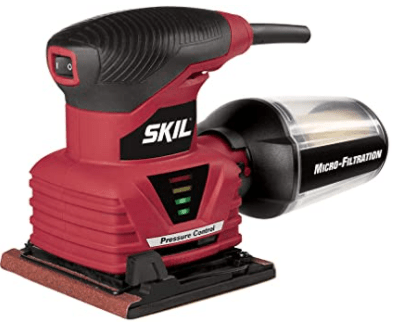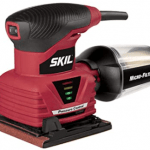Last Updated on April 6, 2021 by James
There are a range of sanders in the market and each type of sander comes with different application and usage so it it important for you to understand the different types before you decide to purchase one for yourself. Whether it be a belt, orbital, palm, random orbital, detail or a multi-tool sander – they all have their own advantages and disadvantages. In this article we will share with you a thorough guide on the most common and popular types of sanders and which could be ideal for your work purpose.
Types of Sanders
Let’s begin with understanding the different types of sanders and what are they useful for:
1. Belt Sander
An electric belt sander makes use of a continuous loop of abrasive paper which is referred to as a sanding belt. The belt is looped around two drums which are spun by the motor. This motor helps to move the paper in one direction continuously. They can have an aggressive action over wooden surface, as they are mostly used with coarse grit sanding paper. This helps in rapid stock and rough removal which makes the belt sander an ideal tool for finishing processes. They are mostly used on wooden surfaces, however, electric belt sanders are also applicable on plastics. You will get various options with the belts up to four inches of width and the speed will also vary allowing you with flexible usage.
2. Orbital Sander
Orbital sanders are also known as finishing sanders or half sheet sanders as they have a base which can move inside tighter spaces and circles (orbits) so as to perform the sanding actions. This prevents too many scratches and will leave the surface with a finer finish. It could come with a lower stock removal rate but an electric orbital sander is powerful enough to be used on most types of flat and medium-sized areas. You can smoothen rough materials such as plasters and paints between coats. They might not be as popularly used as a belt sander but they are an affordable solution to most wood sanding projects.
3. Random Orbital Sander
Random Orbital Sander is also known as dual action sander or eccentric sander. They are a versatile sander option which has become a sander of choice for most tradesman in the recent few decades. The orbital motion in a random orbital sander is the same as an orbital sander. The pad also spins around a spindle at the same time as an orbital sander. This means that the grit travels in different path on each orbit. This helps to eliminate the swirl patterns which is left by orbital sanders.
An electric dual action sander is the one sander that bridges the gap between a belt sander and an orbital sander. It provides you with a high level of stock removal on larger areas. It can also create a finer finish without much better. Some of the high end models also come with a boost function which gives a surge of power to remove materials at a quicker speed. Most of the random orbital sanders are capable of sanding a wide range of materials such as wood, sheet steel and plastic.
4. Palm Sander
Palm sanders are nothing but an orbital sander which comes with a smaller baseplate. It is designed in a way that it fits comfortably on the palm of your hand. Even though they are not as powerful as an orbital sander but they are fairly lightweight and they can be operated with a single hand on any vertical surface. They are also low in their cost and are ideal for light duty jobs which concentrates on smaller areas.
5. Electric Detail Sander
An electric detail sander is similar to a palm sander with the one difference that it has a triangular shaped base plate. This is advantageous in the sense that they allow for easier navigation for awkward shapes and also help in accessing in the required corners. For awkward sanding jobs such as window frames – they provide with better results and also helps you finish the work quicker.
How To Use A Detail Sander? – FirstWoodWorker
6. Multi Tool Sander
An electric multi-tool sander which is also known as multi-cutter is a small but powerful tool which can be used for a wide range of tasks. It rotates the attached accessory side by side to a certain degree thereby producing a sanding movement. They come in two options: corded multi-tools and cordless multi-tools. It is ideal for small and intricate jobs but they have a higher speed of stock removal. The shape of the sanding pad is triangular and smaller than the pad size of a detail sander, so that helps you in reaching out to the tighter corners with comfort. They also come with accessories that help you in sanding away tile adhesive and mortar.
Conclusion
When you are getting ready for a job, you would of course want the best sander for the type of work you will be doing. Many of the sanders might seem similar to you so see which features are the ones you will require from a sander and make them your common sticking points. Also note that most sanders use sandpaper and they start at 60 grit and become finer as the grit count goes up. So keep all of these features and context in mind before you choose a type of sander for your individual work purpose.

